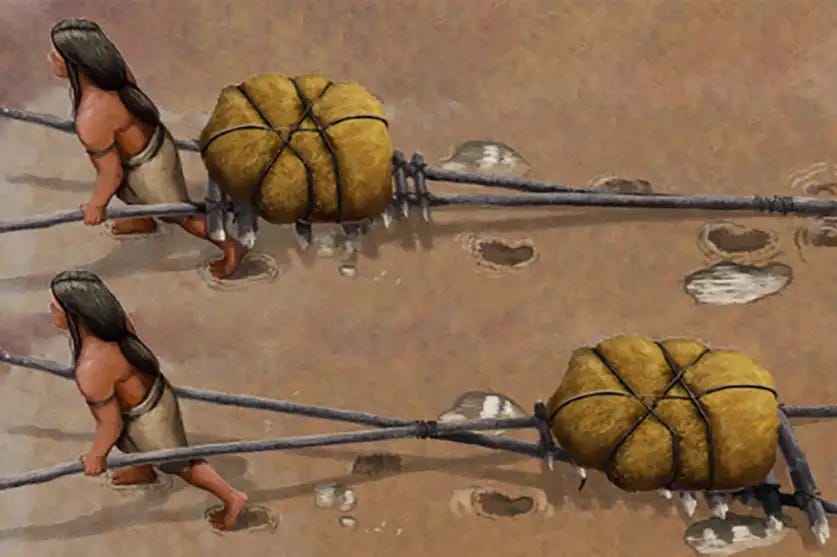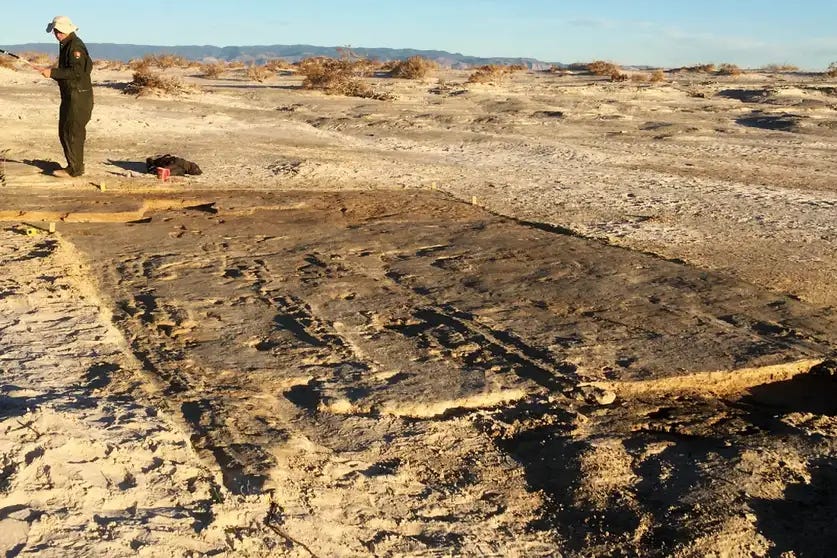
In the shifting gypsum sands of White Sands National Park in New Mexico, a series of fossilized human footprints have surfaced, casting a striking new light on the ingenuity of Ice Age inhabitants. These tracks, dated to approximately 22,000 years ago, provide the oldest known evidence of human transport technology—suggesting that long before the invention of the wheel, prehistoric peoples were building and using travois-like devices to move heavy loads across vast landscapes.

The findings, published in Quaternary Science Advances, come from a research team led by Matthew R. Bennett of Bournemouth University. Their study focuses on linear traces found alongside human footprints in the park’s Alkali Flat region—traces that appear to be drag marks made by wooden poles in contact with the ground. The researchers propose that these markings, found in association with human footprints, may represent the earliest known use of a human-drawn transport system.
“These features, whatever their age, demonstrate traditional ancient Indigenous practices, driven by the universal human need to transport possessions and resources.”
A travois—a simple sled-like structure made from wooden poles tied in an A-frame—has long been documented in Native American cultures. Historically, it was used by Plains peoples to haul loads across the land, often drawn by horses or dogs. But the traces uncovered at White Sands suggest that humans alone may have pulled these devices during the Last Glacial Maximum, thousands of years before the domestication of draft animals.
The study identified three distinct types of track features:
-
Single groove tracks, possibly from a single-pole travois.
-
Broader, shallow runnels, suggesting a larger structure.
-
Two parallel grooves, consistent with a travois made from two poles tied together, leaving evenly spaced markings.
“The most parsimonious explanation is that they represent drag marks formed by travois consisting of a single pole or crossed poles pulled by humans, presumably during the transport of resources.”
Unlike sleds or carts, travois do not require wheels—making them well suited for landscapes like White Sands, where loose sand and soft sediments would have made rolling transport inefficient. The presence of footprints associated with the drag marks suggests that the load bearers were likely small groups moving together, possibly carrying food, firewood, or other essential goods.
Before jumping to conclusions, the researchers carefully considered alternative explanations for the linear features. Could they have been made by animals dragging objects? Or by natural forces such as water or wind movement? The answer, they argue, is no.
-
Animal activity? While mammoths, giant sloths, and other Ice Age creatures left their own footprints in White Sands, their tracks do not align with the drag marks. There’s no indication that large animals like mammoths dragged logs or sticks in a way that would match these parallel grooves.
-
Natural formations? The markings are distinct from erosion patterns, ruling out fluvial activity or shifting sediment. Additionally, the grooves are located in areas where lake sediments were absent, making water-related explanations unlikely.
-
Primitive boats? Some researchers have speculated that Pleistocene hunter-gatherers used watercraft. However, the parallel grooves are inconsistent with boat keels being dragged along shorelines, and White Sands lacks evidence of reed boats or canoes from this period.

This leaves one compelling explanation: humans, burdened with supplies, innovated an early transport system that helped them survive in an unforgiving Ice Age landscape.
The implications of this discovery go beyond technology. They offer a rare window into daily survival strategies of some of the earliest known inhabitants of North America. The presence of multiple footprints walking alongside the travois tracks suggests a cooperative effort—perhaps families or small social groups working together to transport goods.
Moreover, this discovery adds weight to the controversial theory that humans arrived in the Americas much earlier than previously thought. The conventional timeline places the first migrations at around 15,000 years ago, following the retreat of the Ice Age glaciers. However, the dating of the White Sands footprints to 22,000 years ago (or possibly earlier) aligns with other emerging evidence suggesting that humans may have been present in the Americas as far back as 30,000 years ago.
“The peopling of the Americas debate is a very controversial one, but we’re fairly confident about the dates.”
Despite the excitement around these findings, some researchers remain skeptical. The dating of the footprints has been questioned by those who argue that environmental factors could have altered the stratigraphy of the site. Further studies will need to confirm whether these marks truly date back to the Last Glacial Maximum, or if they are younger than initially thought.
Additionally, if these marks indeed represent transport technology, what exactly were these early humans carrying? Could they have been moving food, shelter materials, or even ritual items? Were these travois built for long-distance travel, or simply for short-term use within seasonal camps?
Another lingering question is whether similar evidence exists elsewhere. Given that travois technology is unlikely to leave behind durable artifacts, identifying similar trackways in other ancient landscapes could help confirm the widespread use of this technology among early humans.
This discovery at White Sands challenges long-held assumptions about early human migration, transport technology, and daily life. The evidence suggests that Ice Age peoples were not just moving through the landscape but actively shaping it—engineering solutions to the hardships they faced.
The humble travois, often overlooked in discussions of prehistoric innovation, may have played a critical role in the survival and expansion of human populations. If confirmed, these 22,000-year-old footprints will stand as a testament to the ingenuity of our ancestors—proving that even before the invention of the wheel, humans were finding creative ways to carry their world with them.
-
Bennett, M. R., et al. (2025). The ichnology of White Sands (New Mexico): Linear traces and human footprints, evidence of transport technology? Quaternary Science Advances. DOI: 10.1016/j.qsa.2025.100274
-
Bustos, D. et al. (2021). Footprints preserve terminal Pleistocene hunt? Science. DOI: 10.1126/science.abg7586
-
Pigati, J. S. et al. (2023). Footprints evidence of the earliest Americans? Science. DOI: 10.1126/science.adj1721






